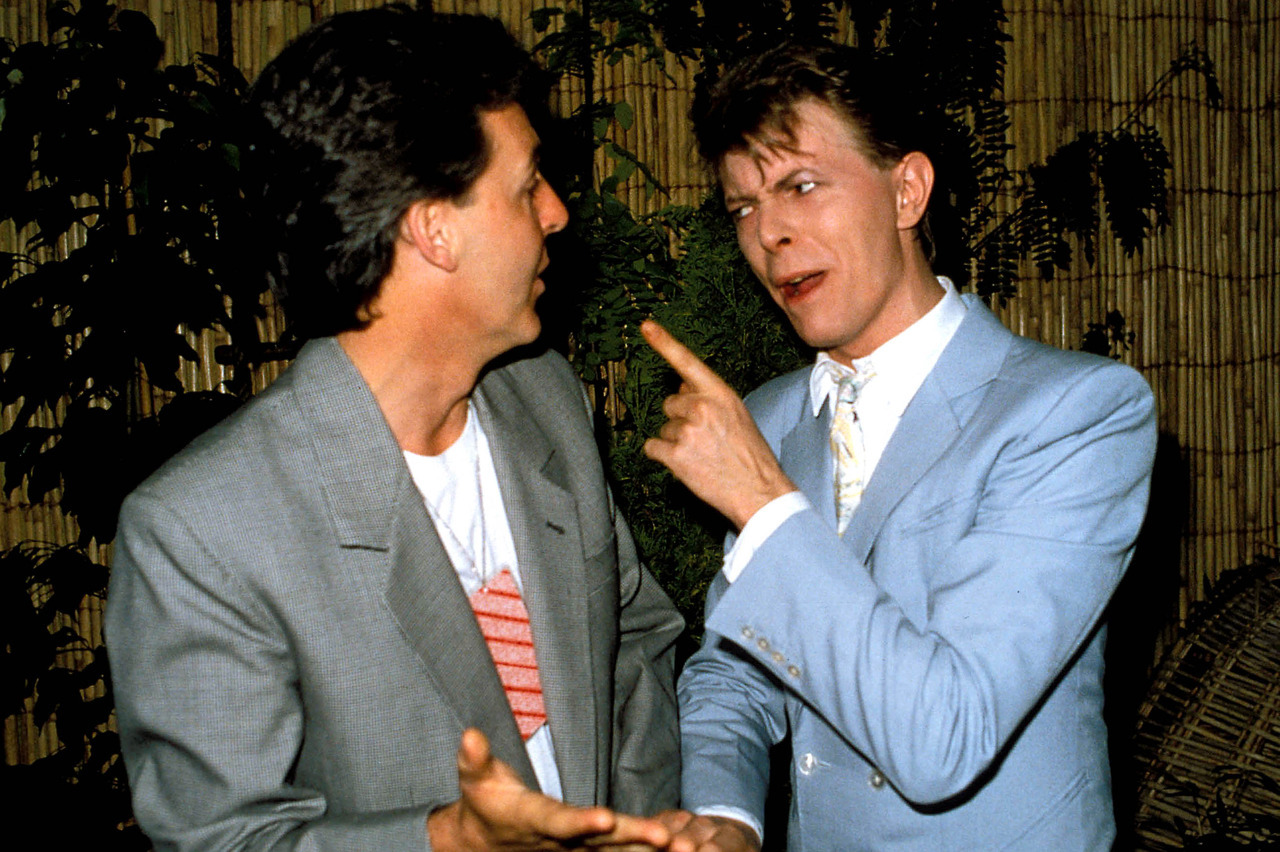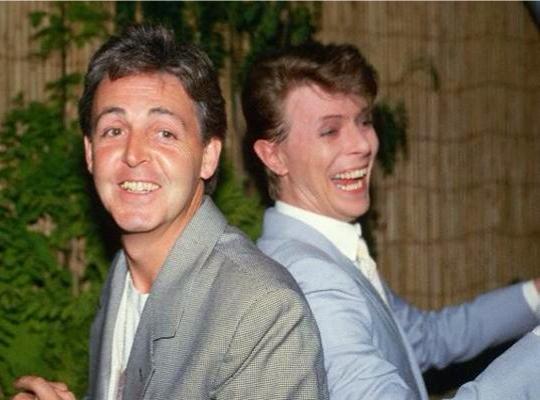David Bowie and Paul McCartney: boats against the current…
By Jim Booth
MAR 12 2017
Successful artists feel constant commercial pressure to repeat their sales success – a pressure that can make any artist choose a safe route.
…so we beat on, boats against the current, borne ceaselessly into the past. – F. Scott Fitzgerald

David Bowie and Paul McCartney (image courtesy Pinterest)
I watched a couple of documentaries (thank you Open Culture) this week featuring rock stars from the classic era, one about a living musician, the other about one who has, alas, shuffled off this mortal coil. What I found most interesting about each of these films is the reminder that it is very difficult for any successful artist, especially for a David Bowie or Paul McCartney, who have enjoyed success at the highest level of their art, to move forward. In a popular art form such as rock music has been, part of the problem is commerce; one who is successful and whose art is embraced by a wide public sells much “plastic ware,” as Roger McGuinn and Chris Hillman wrote. They feel constant commercial pressure to repeat their sales success – a pressure that can make any artist choose a safe route.
Another, perhaps even greater part of the problem, especially for an artist like Bowie or McCartney, comes from those whose admiration (and money) made them acclaimed, and wealthy: fans. Any artist like Bowie or McCartney with a long career arc (given that the average length of a popular musical star’s career is 18 months, the nearly 50 year career of Bowie and the 50+ year career of McCartney are by any measure remarkable) is bound to have to deal with one of the strongest desires of fans as they, like their heroes, age – nostalgia for past works which form, after all, the soundtracks of their lives.

Paul McCartney, as I have written before, often hides his own pain and desire behind a facade of charm and ingratiating pleasantness. In the 2005 documentary, Paul McCartney: Chaos and Creation at Abbey Road, McCartney couches his pitch for his then newest album Chaos and Creation in the Backyard to a select audience in Abbey Road’s Studio B (where the Beatles recorded some of the most famous songs in the history of popular music) in a nostalgic look back at the studio’s history. During the hour long documentary he covers the very first Lennon/McCartney/Harrison recording, their original composition “In Spite of all the Danger.” He covers Eddie Cochran’s “Twenty Flight Rock,” the song that got him into John Lennon’s band, The Quarrymen. He plays “Heartbreak Hotel” on Bill Black’s stand up bass, the bass that Black played while touring with Elvis in the mid-fifties. And in one of the most affecting moments, McCartney plays and explains the mellotron, finishing his explanation by playing the opening line of “Strawberry Fields,” the song most associated with the instrument. Through it all McCartney is by terms jocular, earnest, even maudlin, all the while charming the live audience in the studio – and, one supposes, viewers, too. Both early and late in the program McCartney records before the live audience – first, an unusual re-imagining of “Band on the Run” for a BBC Radio promo; later, an audience participation recording of a song for which McCartney composes extempore lyrics. In both cases McCartney subtly makes the plea for his audience to recognize the need for artists to re-imagine, experiment, move forward. Of course, being Macca and wanting to be beloved (as he is, which he surely knows), he placates and charms his audience by giving them a lot of what they want – Beatles songs and lore.

* * *
The David Bowie documentary, David Bowie: Sound and Vision, is a more standard documentary tracing Bowie’s career from its beginnings in the mid-sixties until 2002. The documentary explores in particular a phase of Bowie’s career – the period that made him a huge star, the Ziggy Stardust phase – and the struggle Bowie went through to escape the persona he created that made him world famous. Any rock fan knows the famous, slightly surreal clip of David Bowie singing “Little Drummer Boy” with Bing Crosby on Crosby’s last Christmas special. It was something of a stunt – but it took Bowie’s image light years away from Ziggy and freed him to move forward through the various personas he adopted through his career. Getting free of Ziggy was a huge artistic breakthrough for Bowie, and it led to the creative evolution that gave us classics such as Young Americans, Scary Monsters, Let’s Dance, and Tin Machine. Through all his persona changes, Bowie’s artistic mission never changed; he wanted to move his work forward, to find new ways of expressing a vision. When his career stalled in the late eighties, in a bold move (the most notable characteristic of Bowie is arguably boldness) he abandoned being David Bowie and immersed (perhaps submerged might be a more accurate term) himself in Tin Machine in the anti-persona “Just the Singer.” The move gave him creative space and Bowie found he was able to grow again as an artist, releasing a series of forward looking albums that culminated in two final masterpieces, The Next Day and Black Star. While the documentary ends in 2002, with those last two brilliant works in the future, it makes sense to mention them. Bowie’s creative journey, made possible by his being able to escape typecasting as Ziggy, was accomplished by a feat both charming and campy and brilliantly authentic. Bowie, as he always was, was looking ahead – to a day when he would no longer be an outsider, when he might find himself as predictably comforting and mainstream as – well, Bing Crosby.

That day never came for Bowie. While he maintained his popularity, he was always viewed as an innovator and forward moving artist. To the end he was true to his artistic vision and followed his muse wherever she led.
It did come for McCartney, of course. The Beatles are musical institutions and Paul and Ringo are close to institutions themselves. Paul in particular has embraced the role of musical ambassador – and as a result his concerts (he still tours to sell out crowds well into his seventies) are cross generational love fests that allow Paul to showcase new work while doing what he does best – evoke the love of audiences for what the Beatles mean to fans past and present.
Whose vision of the artist’s mission is a truer one is open to debate. The unarguable fact is that both men strove (and strive) to give us their best.


Paul's page on internet
ResponderEliminar